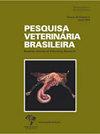不同菌株新城疫的气管接种后反应vírus
IF 0.8
4区 农林科学
Q3 VETERINARY SCIENCES
引用次数: 0
摘要
摘要:本研究通过对肉鸡气管的组织形态学和组织病理学分析,评价两种牛瘟病毒(NDV)慢生疫苗株和表达NDV融合糖蛋白的重组火鸡疱疹病毒(rHVT)疫苗接种后对肉鸡的反应。在控制温度、光照和通风的条件下,将245只小鸡随机安置在三个不同的围栏中。每个圈地代表一种疫苗株,按给药途径分组。每个街区也有自己的对照组,由未接种疫苗的鸟类组成。疫苗的毒株是phyv . lmv .42根据脑内致病性指数(ICPI)选取rHVT-NDV血清3型毒株(ST3)作为非ndv感染的代表。在接种后2、4、7、14和21天,收集气管中间三分之一的碎片并进行常规组织学处理。为了进行组织形态学分析,我们拍摄了切片,并测量了气管粘膜的厚度。统计分析采用双因素方差分析和Tukey事后检验,显著性水平为5%。组织病理学评价,病变描述为强度和分布的程度。经眼路给药后4 d和14 d, LS毒株气管黏膜增厚(分别为20.85±7.31μm和26.97±5.50μm)显著高于其他毒株(p<0.05),这与LS毒株出现严重的组织病理病变,表现为充血、粘液腺体增生、中度脱脱和多灶性淋巴组织细胞炎性浸润有关。接种ST3菌株21 d时,肉鸡气管粘膜病变更加离散,增厚程度降低(23.23±7.62μm;P <0.05)。本组病变仅为出血、脱落及轻度局灶性淋巴细胞炎性浸润。气管组织形态学和组织病理学结果表明,接种rHVT-NDV血清型3株疫苗后气管病变程度低于本研究分析的其他疫苗株。本文章由计算机程序翻译,如有差异,请以英文原文为准。
Tracheal post-vaccinal reaction to different strains of Newcastle disease vírus
ABSTRACT: The aim of the present study was to evaluate the post-vaccinal reaction to two lentogenic vaccine strains of Newcatle disease virus (NDV) and a recombinant turkey herpesvirus (rHVT) vaccine expressing the fusion glycoprotein of NDV in broiler chickens through histomorphometric and histopathologic analyses of the trachea. The experiment involved 245 chicks housed in randomized blocks with three different enclosures under controlled conditions of temperature, light and ventilation. Each enclosure represented a vaccine strain and was divided into groups according to the administration route. Each block also had its own control group composed of unvaccinated birds. The vaccine strains PHY.LMV.42 (PL42) and La Sota (LS) were selected according to the Intracerebral Pathogenicity Index (ICPI) and the rHVT-NDV Serotype 3 strain (ST3) was selected for representing non-NDV infection. At two, four, seven, 14 and 21 days post vaccination, fragments from the middle third of the trachea were collected and submitted to routine histological processing. For the histomorphometric analysis, the slides were photographed, and the thickness of the tracheal mucosa was measured. Statistical analysis involved two-way ANOVA and Tukey’s post-hoc test with a 5% significance level. For the histopathological evaluation, lesions were described as to the degree of intensity and distribution. At four and 14 days post vaccination with the LS strain administered by the ocular route, the means of thickening of the tracheal mucosa (20.85±7.31μm and 26.97±5.50μm, respectively) were significantly higher (p<0.05) than for all other strains, which was related to the severe histopathological lesions found in this group, characterized by hyperemia, hyperplasia of the mucous glands, moderate deciliation and multifocal lymphohistiocytic inflammatory infiltrate. At 21 days, broiler chickens vaccinated with the ST3 strain showed more discrete lesions and less thickening of the tracheal mucosa (23.23±7.62μm; p<0.05) in comparison with other studied strains. The lesions found in this group were only hemorrhage, deciliation and mild focal lymphocytic inflammatory infiltrate. The results of the histomorphometry and histopathology of the trachea indicated that vaccination with rHVT-NDV Serotype 3 strain induced lower degree post-vaccine tracheal lesions compared to other vaccine strains analyzed in this study.
求助全文
通过发布文献求助,成功后即可免费获取论文全文。
去求助
来源期刊

Pesquisa Veterinaria Brasileira
农林科学-兽医学
CiteScore
1.30
自引率
16.70%
发文量
41
审稿时长
9-18 weeks
期刊介绍:
Pesquisa Veterinária Brasileira - Brazilian Journal of Veterinary Research (http://www.pvb.com.br), edited by the Brazilian College of Animal Pathology in partnership with the Brazilian Agricultural Research Organization (Embrapa) and in collaboration with other veterinary scientific associations, publishes original papers on animal diseases and related subjects. Critical review articles should be written in support of original investigation. The editors assume that papers submitted are not being considered for publication in other journals and do not contain material which has already been published. Submitted papers are peer reviewed.
The abbreviated title of Pesquisa Veterinária Brasileira is Pesqui. Vet. Bras.
 求助内容:
求助内容: 应助结果提醒方式:
应助结果提醒方式:


